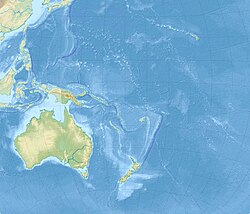Auckland (/ˈɔːklənd/ AWK-lənd;[6] Māori: Tāmaki Makaurau) is a large metropolitan city in the North Island of New Zealand. It has an urban population of about 1,531,400 (June 2024).[4] It is located in the greater Auckland Region, the area governed by Auckland Council, which includes outlying rural areas and the islands of the Hauraki Gulf, and which has a total population of 1,798,300 as of June 2024.[4] It is the most populous city of New Zealand and the fifth largest city in Oceania. While Europeans continue to make up the plurality of Auckland's population, the city became multicultural and cosmopolitan in the late-20th century, with Asians accounting for 31% of the city's population in 2018.[7] Auckland has the fourth largest foreign-born population in the world, with 39% of its residents born overseas.[8] With its sizable population of Pasifika New Zealanders, the city is also home to the largest ethnic Polynesian population in the world.[9] The Māori-language name for Auckland is Tāmaki Makaurau, meaning "Tāmaki[clarification needed] desired by many", in reference to the desirability of its natural resources and geography.[10]
Auckland lies between the Hauraki Gulf to the east, the Hunua Ranges to the south-east, the Manukau Harbour to the south-west, and the Waitākere Ranges and smaller ranges to the west and north-west. The surrounding hills are covered in rainforest and the landscape is dotted with 53 volcanic centres that make up the Auckland Volcanic Field. The central part of the urban area occupies a narrow isthmus between the Manukau Harbour on the Tasman Sea and the Waitematā Harbour on the Pacific Ocean. Auckland is one of the few cities in the world to have a harbour on each of two separate major bodies of water.
The Auckland isthmus was first settled c. 1350 and was valued for its rich and fertile land. The Māori population in the area is estimated to have peaked at 20,000 before the arrival of Europeans.[11] After a British colony was established in New Zealand in 1840, William Hobson, then Lieutenant-Governor of New Zealand, chose Auckland as its new capital. Ngāti Whātua Ōrākei made a strategic gift of land to Hobson for the new capital. Hobson named the area after George Eden, Earl of Auckland, British First Lord of the Admiralty. Māori–European conflict over land in the region led to war in the mid-19th century. In 1865, Auckland was replaced by Wellington as the capital, but continued to grow, initially because of its port and the logging and gold-mining activities in its hinterland, and later because of pastoral farming (especially dairy farming) in the surrounding area, and manufacturing in the city itself.[12] It has been the nation's largest city throughout most of its history. Today, Auckland's central business district is New Zealand's leading economic hub.
The University of Auckland, founded in 1883, is the largest university in New Zealand. The city's significant tourist attractions include national historic sites, festivals, performing arts, sports activities and a variety of cultural institutions, such as the Auckland War Memorial Museum, the Museum of Transport and Technology, and the Auckland Art Gallery Toi o Tāmaki. Its architectural landmarks include the Harbour Bridge, the Town Hall, the Ferry Building and the Sky Tower, which is the second-tallest building in the Southern Hemisphere after Thamrin Nine.[13] The city is served by Auckland Airport, which handles around 2 million international passengers a month. Despite being one of the most expensive cities in the world,[14] Auckland is one of the world's most liveable cities, ranking third in the 2019 Mercer Quality of Living Survey and at first place in a 2021 ranking of the Global Liveability Ranking by The Economist.[15][16][17]
- ^ Cite error: The named reference
City_of_Sailswas invoked but never defined (see the help page). - ^ Rawlings-Way, Charles; Atkinson, Brett (2010). New Zealand (15th ed.). Footscray, Vic.: Lonely Planet. p. 125. ISBN 978-1742203645. Retrieved 6 October 2020.
- ^ Cite error: The named reference
Areawas invoked but never defined (see the help page). - ^ a b c "Aotearoa Data Explorer". Statistics New Zealand. Retrieved 26 October 2024.
- ^ "Quarterly Economic Monitor | Auckland | Gross domestic product". Archived from the original on 24 December 2022. Retrieved 1 July 2022.
- ^ Deverson, Tony; Kennedy, Graeme, eds. (2005). "Auckland". The New Zealand Oxford Dictionary. Oxford University Press. doi:10.1093/acref/9780195584516.001.0001. ISBN 978-0-19-558451-6. Archived from the original on 21 November 2022. Retrieved 21 November 2022.
- ^ "New Zealand's population reflects growing diversity | Stats NZ". www.stats.govt.nz. Archived from the original on 11 August 2023. Retrieved 17 November 2021.
- ^ Peacock, Alice (17 January 2016). "Auckland a melting pot - ranked world's fourth most cosmopolitan city". Stuff. Archived from the original on 21 October 2022. Retrieved 31 July 2023.
- ^ "Auckland and around". Rough Guide to New Zealand, Fifth Edition. Archived from the original on 27 February 2008. Retrieved 16 February 2010.
- ^ "About Auckland". The Auckland Plan 2050. Archived from the original on 17 January 2019. Retrieved 3 January 2019.
- ^ Ferdinand von Hochstetter (1867). New Zealand. p. 243. Archived from the original on 12 January 2009. Retrieved 19 June 2008.
- ^ Margaret McClure, Auckland region, http://www.TeAra.govt.nz/en/auckland-region Archived 5 November 2013 at the Wayback Machine
- ^ "Tallest building in southern hemisphere approved". ABC News. 18 March 2013. Archived from the original on 24 December 2022. Retrieved 4 May 2022.
- ^ "Auckland among world's most expensive cities". The New Zealand Herald. 31 December 2016. Archived from the original on 28 August 2017. Retrieved 29 August 2017.
- ^ "Global Liveability Index 2021". The Economist. Archived from the original on 9 June 2021. Retrieved 9 June 2021.
- ^ "Best UK cities revealed in Mercer's quality of life rankings for 2019". Evening Standard. 13 March 2019. Archived from the original on 30 May 2019. Retrieved 31 May 2019.
- ^ "Quality of Living City Ranking". Mercer. 2019. Archived from the original on 18 April 2018. Retrieved 31 May 2019.









